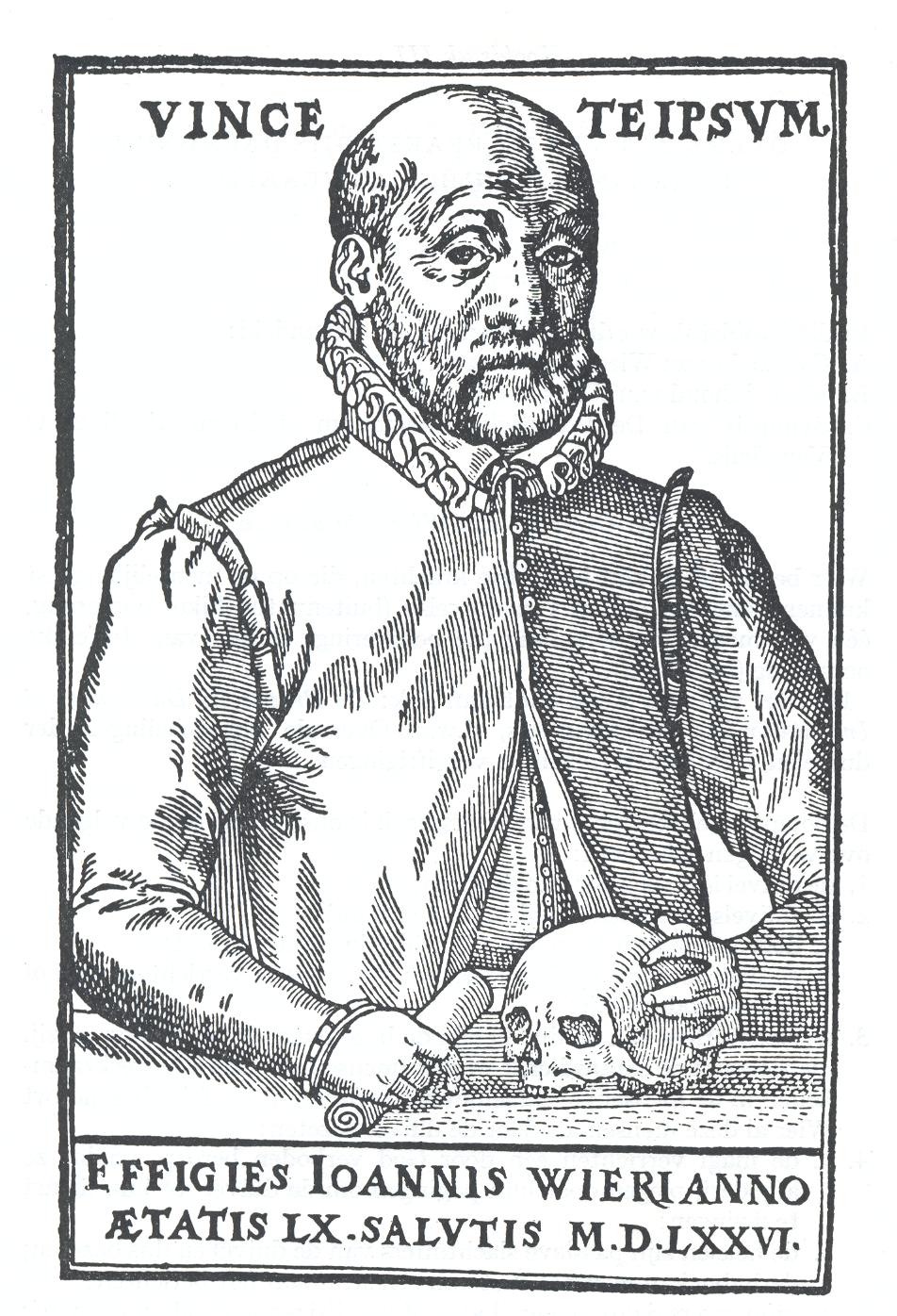Biography Jan Wier

A heretical physician for the witches. Jan Wier (1515-1588)
The physician Jan Wier is known as the first serious opponent of the witch persecution. In his books De praestigiis daemonum or On diabolic delusions of 1563 and De lamiis or On witches of 1577 he called it nonsense that old women made a pact with the devil and that they thus obtained magical powers by which they caused harm to others. In his view, the witch trials were unlawful because they dealt with non-existing offences and because suspects were tortured, humiliated, confined in degrading circumstances and subjected to the water ordeal. In contrast to many of his contemporaries he made a clear distinction between witches and heretics even though he considered burning, hanging or drawing and quartering unacceptable for both groups.
Because Jan Wier described some witches as mentally ill, he counts as a founder of modern psychiatry. He furthermore advocated the necessity of a human treatment of (some) suspects, so that he has been presented as a champion of human rights avant la lettre. Not surprisingly, therefore, he has known numerous admirers including Karl Marx and Sigmund Freud. Critics believe that he inadvertently stirred up the witch persecution, that he wrongly counts as a figure-head of psychiatry or even that he unfavourably influenced the discipline. In the second half of the twentieth century, for instance, antipsychiatrist Thomas Szasz viewed him as the founder of a health care system that confined and silenced troublesome individuals.
Who was Jan Wier and what made him develop views that were in his time all but popular? What is his societal and scientific legacy? Where do the remarkably contradictory views on his importance come from and how come that the public at large has next to forgotten him?
Sources
This biography differs from previous studies on Jan Wier in that it includes his complete works – and not just On diabolic delusions and On witches – in the analysis for the first time. Doing so allows developing a clearer understanding of his motives and his intellectual and societal legacy. Other sources that this biography builds on are texts written by opponents, allies, followers and admirers of Jan Wier as well as his correspondence, and the correspondence of his brothers, his teacher, his sons, his friends, his employer and a fellow courtier. These sources are supplemented with, among others, matriculation lists of universities and court documents. Relevant secondary sources are the nineteenth-century biographies of Jan Wier by Jacobus Scheltema, Alexandre Axenfeld, Carl Binz and Heinrich Eschbach, the twentieth-century biographies by Leonard Dooren, Jan Jacob Cobben and Rudolph of Nahl and the twenty-first-century biography by Michaele Valente. Additional information comes from biographies of relatives, friends, acquaintance, fellow courtiers, opponents, allies and other contemporaries. Finally, publications are studied on the witch craze, occult traditions, university history, medical history, history of science, the Dutch Revolt, the (Counter-) Reformation and the climate in the sixteenth century.
. These sources are supplemented with, among others, matriculation lists of universities and court documents. Relevant secondary sources are the nineteenth-century biographies of Jan Wier by Jacobus Scheltema, Alexandre Axenfeld, Carl Binz and Heinrich Eschbach, the twentieth-century biographies by Leonard Dooren, Jan Jacob Cobben and Rudolph of Nahl and the twenty-first-century biography by Michaele Valente. Additional information comes from biographies of relatives, friends, acquaintance, fellow courtiers, opponents, allies and other contemporaries. Finally, publications are studied on the witch craze, occult traditions, university history, medical history, history of science, the Dutch Revolt, the (Counter-) Reformation and the climate in the sixteenth century.

A new view on his life, works and legacy
This biography summarizes, adjusts and supplements what was already known about the life of Jan Wier: his youth in Grave where he was born, his education in Antwerp and Mechelen as an assistant of Heinrich Cornelius Agrippa, his studies at the university of Paris, his work as a city physician in Arnhem and as a court physician of duke Willem of Cleves, Jülich and Berg, and his death and burial in Tecklenburg. This study shows that in contrast to what has hitherto been assumed his teacher Agrippa was by no means a friend of Erasmus so that the ties with Erasmus that many fellow courtiers in Cleves, Jülich and Berg cherished isolated rather than connected Jan Wier. The biography also clarifies how Jan Wier developed from a catholic to a Lutheran and later on to a Calvinist.
The main insight that emerges from this biography is that defending the witches was not the ultimate aim of Jan Wier. By writing books, he probably wanted to raise his status at the court and foster his career. Content wise he used the witch persecution and the role the clergy played in it to critise the Catholic Church. Only after the first edition of On diabolic delusions became a success, he realized how topical the theme of the witches was and built further on it even though the religious motive would fully never disappear from his work.
The proposed reinterpretation of On diabolic delusions has implications for the reception history of Jan Wier’s work. For instance, it touches the conflict between the view that Jan Wier was the father of psychiatry and the view that this image was artificially created. Supporters of the former view stress that Jan Wier explained principles that are still considered valid today in psychiatry and clinical psychology. He described the role of loneliness and drug use in the etiology of mental disorders, he argued that deviant behavior in isolated communities may be contagious and he developed the concept of irresponsibility. Supporters of the latter view believe that he undeservingly became famous as the father of psychiatry after nineteenth-century French psychiatrists abused him as their figure-head in their struggle against catholic faith.
Because the work of Jan Wier met with a broad response, this biography contributes to medical history, theology, religious studies and literature. Well into the eighteenth century, physicians built on his medical works. As a consequence, he played a crucial role in spreading the fallacy that scurvy could best be fought with herbs that – as it turned out – contained little vitamin C. In the domain of theology, the theologian Heinrich Bullinger wrote a treatise on the witches after and probably because his colleague Thomas Erastus had drawn his attention to On diabolic delusions. In the domain of religious studies, the biography of Jan Wier shows that ‘modern witches’ were known in the sixteenth century but that they were not the ones who were persecuted. Finally, this biography contributes to the history of literature because it sheds more light on the role of Jan Wier as an early printed source on characters as Agrippa, Faust, and the Pied Piper of Hamelin.
Vera Hoorens (Wevelgem, 1963) studied psychology at the Katholieke Universiteit Leuven. In the statute of Aspirant of the Fund for Scientific Research she obtained her doctoral degree in psychology from the same university. As a post-doc of the Fund for Scientific Research she was a Visiting Scholar of Oxford University (Department of Psychology & Wolfson College). Later on she worked as an assistant professor at the University of Groningen and as an associated professor at Tilburg University. She currently is a professor of social psychology at the Katholieke Universiteit Leuven.
Email: Vera.Hoorens psy.kuleuven.be
| Last modified: | 27 February 2019 2.41 p.m. |
